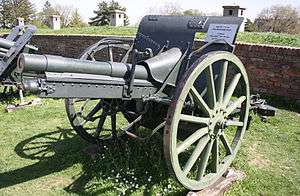Krupp 7.5 cm Model 1903
The Krupp 7.5 cm Model 1903 was a field gun used by a number of European armies in both World War I and World War II. The Model 1903 was a "stock gun" from Krupp that could be supplied to customers on short notice with minor alterations to suit the customers needs.
| 03 L/30 | |
|---|---|
 A Turkish 7.5cm Krupp field gun M1903 | |
| Type | field gun |
| Place of origin | German Empire |
| Service history | |
| In service | 1904-1945
|
| Wars | Balkan Wars World War I World War II |
| Production history | |
| Designer | Krupp |
| Manufacturer | Krupp |
| Specifications | |
| Mass | 1,079 kg (2,379 lb) |
| Barrel length | 2.25 m (7 ft 5 in) L/30 |
| Crew | 7 |
| Shell | 8.671 kg (19 lb 2 oz) |
| Caliber | 75 mm (2.95 in) |
| Breech | Horizontal sliding-block |
| Recoil | Hydro-spring |
| Carriage | Pole trail |
| Elevation | -9° to +15° |
| Traverse | 7° |
| Rate of fire | 8 rpm |
| Muzzle velocity | 546 m/s (1,790 ft/s) |
| Maximum firing range | 6,000 m (6,600 yd) |
Romania acquired 636 of these guns and used them with a more sophisticated sighting device (than the one offered by the Germans) made locally, known as the Ghenea-Korodi sight. By number of guns, this was largest import of a single type of cannon ever made by Romania. It was the mainstay of the Romanian field artillery in World War I, equipping all artillery regiments of the Romanian infantry divisions. The number of these guns in Romanian service had decreased to 312 by 1926.[1] The Romanians used them until 1942, although by this time they had become obsolete.
During First Balkan War 126 field and 6 mountain Ottoman Krupp 7.5 cm Model 1903 guns were captured by Royal Serbian Army and later used in World War I.
The Model 1903 was also bought by Denmark and the Netherlands and used in World War II. The Model 1903 also formed the basis for the Type 38 75 mm Field Gun used by Japan. In Danish service it was known as the 03 L/30 and does not appear to have been modified in any significant way before World War II.
The Dutch bought some 204 of the slightly earlier Kanone M.02/03 and purchased a production-license as well. 120 appear to have been manufactured in the Netherlands, where it was known as the 7-veld. During the 1920s, the Dutch Siderius company a Krupp subsidiary rebuilt their guns to increase their elevation. At least 16 were modified for motorized traction, presumably with steel wheels and pneumatic tires, for service with the Light Division. Gander and Chamberlain claim there were three almost identical versions, the M 02/04, OM 04 and NM 10, but this has not been confirmed. The Germans designated these guns as the 7.5 cm Feldkanone 243(h) after the Battle of the Netherlands.
Danish guns were known in German service as the 7.5 cm Feldkanone 240(d).
References
- Adrian Stroea; Gheorghe Băjenaru (2010). Artileria română în date şi imagini (PDF) (in Romanian). Editura Centrului Tehnic-Editorial al Armatei. pp. 45–46. ISBN 978-606-524-080-3.
Bibliography
- Chamberlain, Peter & Gander, Terry. Light and Medium Field Artillery. New York: Arco, 1975
- Hogg, Ian Twentieth-Century Artillery. New York: Barnes & Nobles, 2000 ISBN 0-7607-1994-2
- Gander, Terry and Chamberlain, Peter. Weapons of the Third Reich: An Encyclopedic Survey of All Small Arms, Artillery and Special Weapons of the German Land Forces 1939-1945. New York: Doubleday, 1979 ISBN 0-385-15090-3
External links
| Wikimedia Commons has media related to 7,5 cm Feldkanone M. 03. |
- Dutch guns on War over Holland
- Version for Romania (1904): Krupp 75mm field gun M. 1904; cavalry version; Canon Krupp 75mm Mle 1904 à Bucarest (museum); Photos of exemplar captured first by the Turks and then by the Australians
- Turkish versions: data for M1903 M1910 M1911; database/photographs of exemplars captured in Palestine and now found in Australia